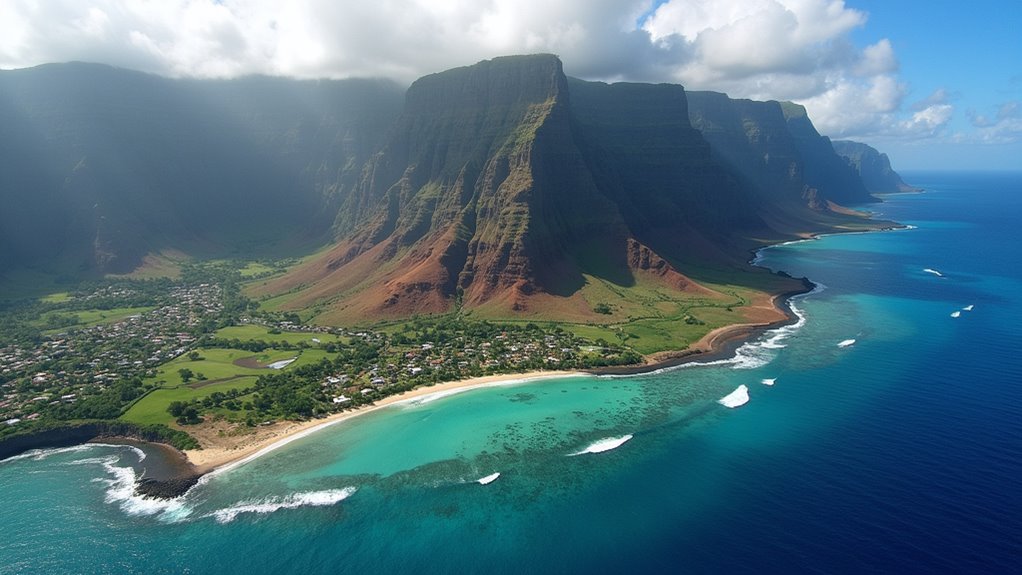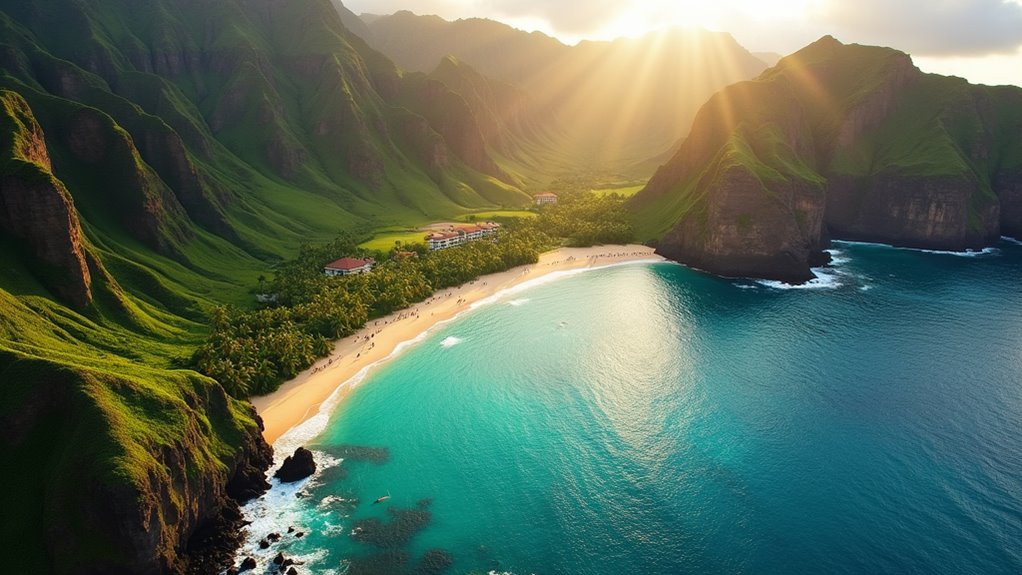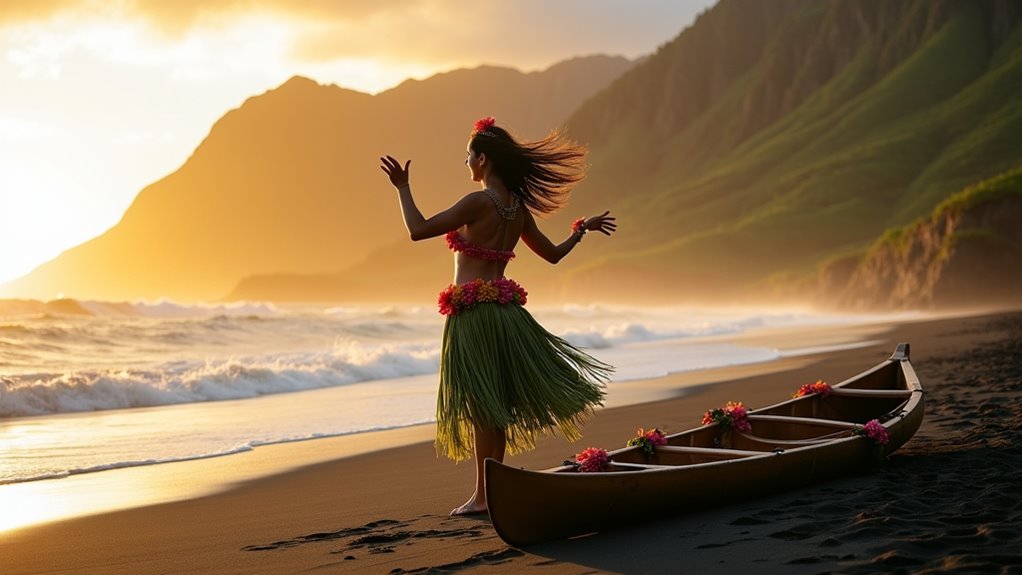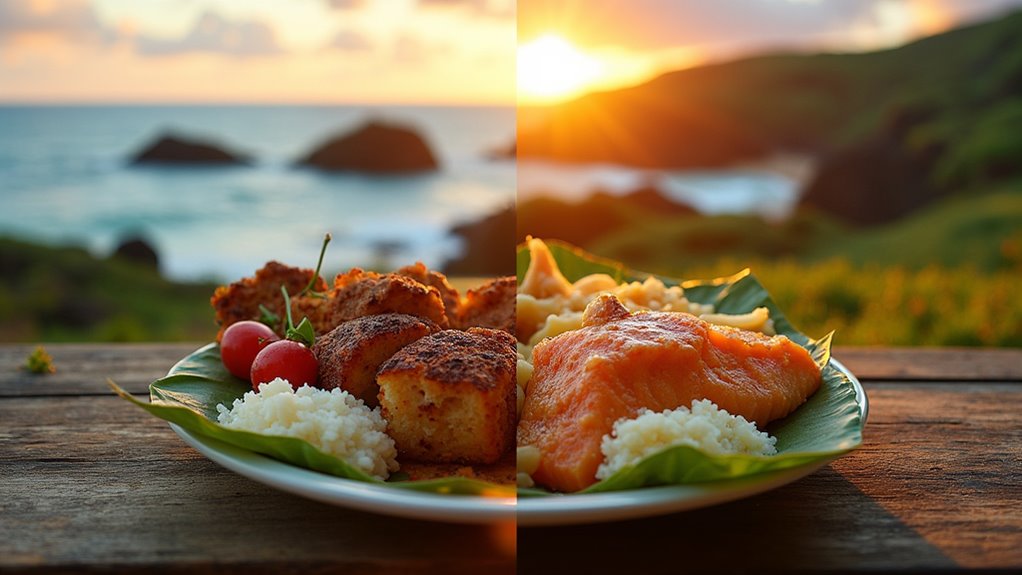Physical Address
304 North Cardinal St.
Dorchester Center, MA 02124
Physical Address
304 North Cardinal St.
Dorchester Center, MA 02124

Kauai's adventure or Molokai's authenticity? Discover which Hawaiian island matches your travel style in this definitive comparison.
Molokai and Kauai offer distinctly different Hawaiian experiences. Kauai delivers adventure with its Na Pali Coast, Waimea Canyon, and developed tourism infrastructure. Molokai provides authentic culture, untouched landscapes, and a slower pace with just 7,000 residents compared to Kauai’s 73,000. Your perfect island depends on your travel style: Kauai for varied activities and amenities, or Molokai for genuine Hawaiian culture and tranquility. Let’s explore what makes each island special.

While both islands are part of the Hawaiian archipelago, Molokai and Kauai represent stark demographic contrasts. Molokai is home to just under 7,000 residents, whereas Kauai’s population approaches 73,000.
Despite sharing Hawaiian roots, Molokai and Kauai stand worlds apart demographically—one with 7,000 souls, the other housing over 70,000.
You’ll find Molokai’s population skews younger (median age 38) compared to Kauai’s (42), with both islands maintaining relatively balanced gender ratios. This gender distribution reflects Hawaii’s overall balanced sex ratio of 50.37% males and 49.63% females.
Molokai proudly maintains strong Native Hawaiian representation, with 60% of residents claiming Hawaiian ancestry.
The island faces significant economic challenges—45% of residents live below 200% of federal poverty guidelines.
Healthcare access is limited, with just one major community health center serving the entire island.
Kauai offers more economic opportunities, better healthcare infrastructure, and attracts both retirees and families seeking its natural beauty and amenities. Kauai is particularly known for its top beaches that provide excellent swimming conditions for residents and visitors alike.
Although both islands offer breathtaking natural beauty, Molokai and Kauai showcase distinctly different landscapes that will leave you awestruck.
On Molokai, you’ll find the world’s highest sea cliffs reaching 3,000 feet above the ocean along the north coast. The island’s east side features the lush Halawa Valley with ancient Hawaiian sites and the 250-foot Moa’ula Falls. Visitors can appreciate the dramatic peninsula views from Kalaupapa Lookout at Palaue State Park, which provides panoramic vistas of the historic settlement below.
Kauai counters with the spectacular Na Pali Coast’s steep, verdant cliffs and the “Grand Canyon of the Pacific,” Waimea Canyon, stretching 10 miles long and 3,600 feet deep. Mount Waialeale, one of earth’s wettest spots, creates a misty, primeval environment. For a different island experience, many travelers combine their Hawaiian adventure with a visit to Lanai’s highlights, known for its unique charm and serenity.
Both islands boast unique ecosystems—Molokai’s Kamakou Preserve and Pepe’opae Bog versus Kauai’s Alakai Swamp and Limahuli Garden.

Where can you experience some of Hawaii’s most diverse coastal treasures? Both Molokai and Kauai offer exceptional shorelines, each with their own distinct character.
Kauai boasts easily accessible beaches like Poipu, known for its calm waters perfect for snorkeling and swimming. You’ll find golden sands and protective reefs at Anini Beach, along with fascinating tide pools. During winter months, Poipu becomes an excellent whale-watching spot. While not on Molokai or Kauai, neighboring Lanai offers top snorkeling spots with crystal clear waters for underwater adventurers.
Molokai counters with remarkable diversity – white, golden, black, and even red sand beaches. While reaching them requires more effort due to the island’s rugged landscape, you’ll be rewarded with seclusion and pristine conditions. Most beaches on the island are shallow or rough, making snorkeling options limited to specific spots like Dixie Maru.
Papohaku Beach offers excellent swimming, while the coastline’s cultural significance adds depth to your experience with historical sites like the Kalaupapa Peninsula.
Both Kauai and Molokai offer thrilling outdoor adventures that showcase Hawaii’s natural wonders, yet they cater to different types of adventurers.
On Kauai, you’ll find Hawaii’s most advanced hiking network with nine state parks, world-class surfing at Hanalei Bay, and the island’s largest zipline. Don’t miss the spectacular helicopter tours or kayaking expeditions to hidden caves along the Na Pali Coast. Visitors can marvel at the breathtaking Waimea Canyon, second largest in the US.
Kauai delivers adrenaline-pumping adventures from rugged hiking trails to soaring ziplines and breathtaking Na Pali Coast expeditions.
Molokai presents a more serene outdoor experience with its pristine nature preserves like Kamakou and Moomomi. The island excels in birdwatching opportunities and cultural walks that connect you with Hawaiian heritage.
The Molokai Forest Reserve offers unique landscapes for exploration, while both islands provide excellent snorkeling—with Kauai’s Tunnels at Hāʻena Beach Park being particularly remarkable. Adventure seekers can discover Best Hawaiian Islands through their distinct and memorable outdoor experiences.

When seeking authentic Hawaiian cultural experiences, Kauai and Molokai offer distinctly affluent opportunities to connect with the islands’ indigenous heritage.
On Molokai, hike through Hālawa Valley with local guides sharing legends and traditions, or visit the 700-year-old fishponds along the south shore—remarkable examples of ancient Hawaiian aquaculture. Experience the island’s sacred cultural sites while embracing the genuine, friendly local culture that embodies traditional Hawaiian values.
Kalaupapa National Historic Park provides insights into 19th-century Hawaiian history.
Visitors should be aware that unlike Jamaica, Hawaii has few dangerous animals to worry about during cultural excursions.
Kauai presents the Wailua Complex of Heiau and sacred sites along the Wailua River. The island’s ancient temples and the legendary Menehune Fishpond showcase pre-contact spiritual practices.
Both islands offer hands-on cultural workshops in lei-making, traditional farming, and Hawaiian language.
For the most immersive experience, attend community events featuring Hawaiian music, dance, and cuisine on either island.
Finding the perfect place to stay can make or break your Hawaiian island experience, with Kauai and Molokai offering distinctly different accommodation landscapes. Kauai boasts numerous luxury resorts with spas and fine dining, particularly in Poipu and Princeville areas.
Meanwhile, Molokai emphasizes rustic charm and local culture.
On Molokai, you’ll find gems like Hotel Moloka’i with its traditional Polynesian village-style rooms and oceanfront views. Castle Molokai Shores offers family-friendly atmosphere and stunning ocean views starting at $139 per night.
Budget travelers can choose from hostels, B&Bs like Ka Hale Mala, or camping options on both islands.
For unique experiences, consider Molokai’s Eclectic Oceanfront Dream condo or family-run accommodations that showcase traditional Hawaiian decor.
If you’re looking for warm weather escapes within North America but want a change from Hawaii, Canada offers surprisingly pleasant options.
Remember to book early for Molokai, as options are limited compared to Kauai’s extensive offerings.

The culinary landscapes of Kauai and Molokai offer distinct flavors that reflect each island’s unique character and cultural influences.
On Kauai, you’ll find exceptionally fresh poke at spots like Konohiki Seafoods, alongside traditional Hawaiian dishes like Loco Moco. The island’s cuisine proudly displays Polynesian, Japanese, Filipino, and Portuguese influences through farm-to-table offerings and authentic bento boxes. Be sure to try Hawaiian plate lunch, a popular local favorite featuring a protein, rice, and macaroni salad. Many Kauai establishments have unpredictable operating hours, especially on the North Shore, making it essential to call ahead or check social media before visiting.
Molokai presents a different experience centered around comfort foods. Molokai Pizza Café serves unique island pizzas like the Big Island pizza alongside weekly specials including Mexican Wednesday and Sunday ribs.
While the island’s fine dining at Hula Shores Restaurant maintains a casual vibe, you’ll notice more mainland American-style dishes with Hawaiian twists, featuring hearty options like kalbi ribs and coconut shrimp.
Traveling between and around Kauai and Molokai presents distinct challenges and opportunities for travelers. You’ll need to fly to either island, as neither has operational ferry services. Once there, rental cars are essential for exploration—book early, especially on Molokai where availability is limited.
Navigating Hawaii’s less-connected islands requires advance planning—flights only, with rental cars strongly recommended for both destinations.
Kauai offers more transportation options with its extensive bus system, taxis, and ride-sharing services.
Molokai’s single two-lane highway and MEO shuttle provide basic transit, embracing the island’s slower pace. Travelers can reach Molokai via 25-minute flights from Oahu’s Honolulu International Airport or either of Maui’s airports.
Both islands have unique driving cultures—Molokai encourages relaxed driving while Kauai balances scenic routes with more developed areas.
Consider renting 4-wheel drive vehicles on Molokai for better access to remote areas, while Kauai’s paved roads accommodate standard rentals for most attractions.
Unlike Caribbean islands such as Barbados or Grenada where inter-island ferries are common, Hawaii’s island-hopping requires air travel exclusively.

Deciding between Kauai and Molokai ultimately depends on what you’re seeking from your Hawaiian adventure.
If you crave dramatic landscapes and hiking opportunities, Kauai’s Na Pali Coast and Waimea Canyon deliver breathtaking experiences. Adventure seekers will appreciate Kauai’s advanced trails while still enjoying amenities in Kapa’a and Lihue. While Kauai offers stunning landscapes, many visitors find Oahu worth visiting for its perfect blend of natural beauty and metropolitan conveniences.
Molokai suits those wanting authentic culture. As the birthplace of hula dance and home to paniolo cowboy culture, it offers genuine Hawaiian traditions. The island’s rural atmosphere and limited development create a perfect retreat for solitude seekers. Visitors particularly value the island for its natural beauty and tranquility rather than extensive snorkeling options.
Families might prefer Molokai’s relaxed pace and community feel, while Kauai works better if you want a balance of adventure and comfort.
Both islands offer excellent snorkeling, wildlife viewing, and local cuisine, just with different levels of accessibility and development.
Whether you choose Molokai’s untouched tranquility or Kauai’s lush grandeur, you’ve found your slice of paradise. Molokai offers authentic Hawaiian culture without the crowds, while Kauai balances natural wonders with tourist amenities. Consider your priorities—solitude or accessibility, rustic or refined. Both islands will leave you spellbound, their beauty etched in your memory like footprints in wet sand. The perfect choice is simply the one that calls to you.